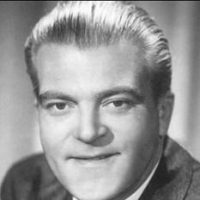
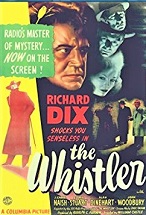 “I am the Whistler, and I know many things, for I walk by night. I know many strange tales, many secrets hidden in the hearts of men and women who have stepped into the shadows. Yes… I know the nameless terrors of which they dare not speak.”
“I am the Whistler, and I know many things, for I walk by night. I know many strange tales, many secrets hidden in the hearts of men and women who have stepped into the shadows. Yes… I know the nameless terrors of which they dare not speak.”
The Whistler (1942-55) aired “Shrunken Head” on June 13, 1942 as the 5th of its 760+ episodes (depending on how one counts). It is the tenth episode of the show we have run since 2017 and only the second since December of 2021. For newcomers, introductory background material on the show is reprised below (it was the most popular west coast radio show for many years), with the background providing context for its not totally unique but unusual narrative format.
There were two attempts for The Whistler to break into the east coast market that didn’t last long (July-September 1946, and March 1947-September 1948) due to mediocre ratings, so if these episodes are counted as part of the overall scheme of things, the total number of shows ends up somewhere around 769. Over its thirteen-year west coast run it never took a summer break and ran continuously, certainly some kind of record, and its sole west coast sponsor, Signal Gas & Oil remained loyal throughout. While the show had several narrators over the years, the one who held the longest tenure and is most associated with the show was Bill Forman (1915-1966, photo top right). Though Forman is the most recognized narrator for his work in most of its later years, two of the show’s earlier narrators would also become 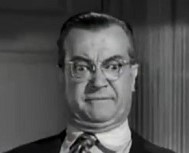 recognizable for both
recognizable for both 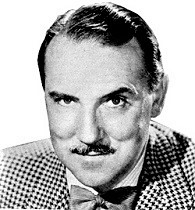 their radio work and television personalities, Joseph Kearns (1907-62, photo at left) being one and Gale Gordon (1906-95, photo at right) being the other. Kearns (as did Gordon) had a long radio career, and would win notoriety for his ability to mimic almost any voice. Combining his amazing vocal talent along with his acting chops, Kearns would find work in hundreds of episodes of radio shows prior to any TV work that came his way. The TV role he was most associated with was of course Dennis the Menace (1959-63), where he played Dennis’s grumpy old neighbor George Wilson. When Kearns died in February of 1962 he was replaced by none other than his long time radio pal Gale Gordon until the show left the air. Another bit of trivia is that Kearns (who portrayed the Whistler in this episode) also wrote the script for “Shrunken Head,” showing once again that he was not only a capable actor with a rare voice talent but a writer as well.
their radio work and television personalities, Joseph Kearns (1907-62, photo at left) being one and Gale Gordon (1906-95, photo at right) being the other. Kearns (as did Gordon) had a long radio career, and would win notoriety for his ability to mimic almost any voice. Combining his amazing vocal talent along with his acting chops, Kearns would find work in hundreds of episodes of radio shows prior to any TV work that came his way. The TV role he was most associated with was of course Dennis the Menace (1959-63), where he played Dennis’s grumpy old neighbor George Wilson. When Kearns died in February of 1962 he was replaced by none other than his long time radio pal Gale Gordon until the show left the air. Another bit of trivia is that Kearns (who portrayed the Whistler in this episode) also wrote the script for “Shrunken Head,” showing once again that he was not only a capable actor with a rare voice talent but a writer as well.
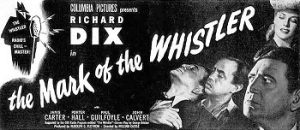
The Whistler has an interesting backstory, and would take much too long to go into here to give it the justice it warrants. A few points of interest will suffice for this offering of the beloved mystery show, the first of which is the use of the narrator as more than just a host. From Jim Ramsburg’s Gold Time Radio entry on The Whistler: “Like The Shadow’s first personification a dozen years earlier, Inner Sanctum’s ghostly Raymond in 1941 and The Mysterious Traveler in 1943, The Whistler stood outside the stories he narrated. Unlike the others, he used a unique second-person, present tense technique as if to talk directly with the central character of his stories – often an innocent drawn into the plot by circumstances or an amateur driven to murder as a last resort.” A second point of interest has to do with the trademark whistling that opens each episode. From Radio Spirits‘ Blog Archive on The Whistler: “The program featured one of radio’s classic openings: a haunting 13-note theme created by Wilbur Hatch (who also composed the show’s eerie mood music). Hatch estimated that only one person in twenty could whistle this exact melody, and for the show’s thirteen-year duration one person pretty much did—a young woman named Dorothy Roberts. In fact, during the war years, Roberts had to get permission from Lockheed (where she worked) to leave her factory job in order to make it to the program and whistle every week.”
The radio show proved popular enough that Columbia Pictures made eight Whistler films from 1944-48, all but one starring Richard Dix: The Whistler (1944), The Mark of the Whistler (1944), The Power of the Whistler (1945), The Voice of the Whistler (1945), Mysterious Intruder (1946), The Secret of the Whistler (1946), The Thirteenth Hour (1947) and The Return of the Whistler (1948). The show was brought to early television in 1954-55, but never caught on. Nevertheless (and due in great measure to roughly 500 of the estimated 700+ original shows still surviving–-and the movies still showing up on classic movie TV channels), The Whistler probably enjoys a larger audience today than it did in its heyday during the Golden Age of Radio.
“Shrunken Head” begins innocently enough with young Marie coming to live with her uncle Peter after her parent’s untimely demise. Uncle Peter is the eccentric old coot and patriarch (now recently confined to a wheelchair) ruling over his mostly empty large old house, known by the locals simply as Medford Manor. Peter, in his younger adventurous days as a jungle explorer, collected souvenirs from his travels, one of which was a shrunken head  that Marie finds truly awful, but that Uncle Peter has affectionately named Charlie. So awful is this tiny decapitated head with its long black hair and wrinkled gray skin, that it affects Marie more than she could ever imagine. So much so that a dream of the shrunken head disturbs her first night’s sleep in this strange new house. It frightens her so much she is thrust into a full blown nightmare and swears the next morning that the head came after her in her sleep. After being calmed down and her fears assuaged (at least for the time being), Marie tries to get a peaceful sleep the next night, but again is plagued by the animated shrunken head invading her sleep. Swearing the head was real, and to prove her nightmare was anything but a dream, she has other members of the household (uncle Peter’s secretary and butler) accompany her to the downstairs room where the head is kept on display. When it is found to be missing… But to learn the secret of the missing artifact and why it has chosen to frighten poor sweet Marie, dear listener, you’ll have to listen to the curious mystery surrounding the “Shrunken Head.”
that Marie finds truly awful, but that Uncle Peter has affectionately named Charlie. So awful is this tiny decapitated head with its long black hair and wrinkled gray skin, that it affects Marie more than she could ever imagine. So much so that a dream of the shrunken head disturbs her first night’s sleep in this strange new house. It frightens her so much she is thrust into a full blown nightmare and swears the next morning that the head came after her in her sleep. After being calmed down and her fears assuaged (at least for the time being), Marie tries to get a peaceful sleep the next night, but again is plagued by the animated shrunken head invading her sleep. Swearing the head was real, and to prove her nightmare was anything but a dream, she has other members of the household (uncle Peter’s secretary and butler) accompany her to the downstairs room where the head is kept on display. When it is found to be missing… But to learn the secret of the missing artifact and why it has chosen to frighten poor sweet Marie, dear listener, you’ll have to listen to the curious mystery surrounding the “Shrunken Head.”
Play Time: 29:30
{After listening to this episode of The Whistler on an a Saturday evening in early June of 1942, the neighborhood gang headed for the local newsstand after church the next day. They were in luck, for a couple of the issues of their summer quarterlies had arrived early. Captain Future (1940-44) was all the rage when it came to a rag tag group of entities accompanying Captain Future around the galaxy helping this “Man of Tomorrow” fight evil villains of all sorts. Edmond Hamilton, known as the “galaxy smasher” would enthrall youngsters of all ages—especially those young at heart—with his inventive, colorful, thrill-a-minute tales. The magazine published 17 quarterly issues before folding, though the adventures of Captain Future and his stalwart cohorts could be found here and there in several other pulps for several years, much to the pleasure of his many fans. fantastic Adventures (1939-53) was one of Ray Palmer’s pulp magazines (he published and then folded many a pulp magazine in his day), founded to run alongside the more famous Amazing Stories. One reliable source comments that fantastic Adventures ran much lighter, “frothier,” stories at first but later turned to much the same material as Amazing did, but with an even more fantastic bent to its stories. Notice that Edmond Hamilton appears in the issue below, and along with his Captain Future magazine must have been having a dandy summer with his name appearing quite often in various places. fantastic Adventures was a monthly in 1942. Planet Stories (1939-55) was one of the most beloved SF pulps of all time, with many of its wildly imaginative planetary romps penned by some of the biggest names in the field now classics. Many times a story giving its audience Pure Entertainment will trump a story attempting to give it a Serious or Deep Think, and such was the case with Planet Stories. A bit of trivia is found in the lower left corner of this Planet Stories cover. The story titled “Out of This World” was written by one Henry Hasse, not the most famous or well known SF author by any stretch. Henry Hasse (1913-1977), however, is credited with co-authoring Ray Bradbury’s first professional sale. It was titled “Pendulum” and ran in the November 1941 issue of Super Science Stories, making Hasse’s cover story in this issue of Planet Stories appearing approximately 8 short months after his collaboration on Bradbury’s first sale seeing print. Planet Stories was a quarterly in 1942.}
[Left: Captain Future, Sum/42 – Center: fantastic Adventures, 6/42 – Right: Planet Stories, Sum/42]
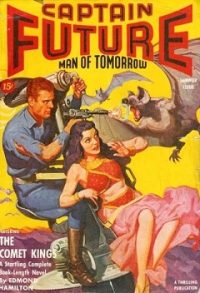

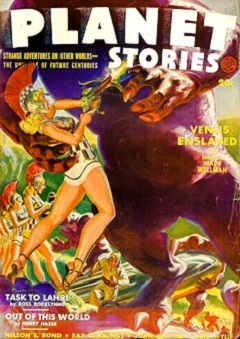
To view the entire list of Old Time Radio episodes go here.